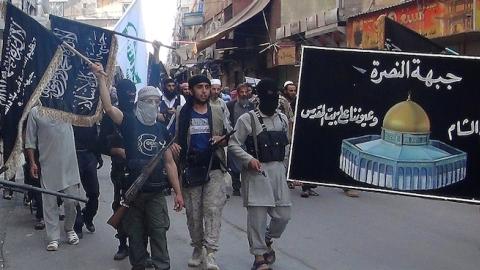After a lengthy trip abroad, I returned to my Jerusalem home with great pleasure. Just two days after my arrival, a cease-fire with Hamas was announced. Another battle in Israel’s long war against its Islamist enemies ended.
Meanwhile, I was continuing my work on a much larger, more deadly conflict that still rages in Syria and Iraq – the broad and bloody sweep of the Islamic State (IS).
On Saturday night, I found myself in the Muslim Quarter in the Old City – a very different neighborhood from my own – where I joined good friends for dinner. Several mosques are in full view from their expansive rooftop terrace. Overlapping, high-volume calls to prayer sometimes caused gaps in our conversation.
But I learned that during the Gaza conflict there had been another unanticipated change in the surroundings, besides fire bombs, stone-throwing and increased police activity: Black flags had appeared on Muslim Quarter rooftops.
“I counted seven black flags flying over various houses,” my friend said. “Some had Arabic writing in white saying, ‘There is no God but Allah, and Muhammad is his divine messenger – the shahada.’” Looking around, I saw three such flags snapping defiantly in the wind, although the others had been removed, thanks to a new law forbidding terrorists’ flags to be displayed in Israel.
The murderous Islamic State is represented by a black flag with white Arabic lettering. That all-too-familiar banner has even appeared on Jerusalem’s Temple Mount and elsewhere in Israel.
I WAS reflecting on this when I received a video from friends. It showed a huge demonstration in Bethlehem’s Manger Square from just over a year before.
To my amazement, I watched as angry Arabs chanted beneath a tide of black flags – the same ones I’d just seen in the Old City.
I’ve since learned that the flag represents radical Islamist group Hizb-ut-Tahrir. Like IS, its goal is the establishment of a pan-Islamist state.
Founded in 1953 by Taqiuddin al-Nabhani in Jerusalem, and now active in more than 40 countries, Hizb-ut-Tahrir also promotes the re-establishment of the Islamic caliphate.
And that, I soon discovered, is the significance of the black banners.
“The real origins of the ‘black flag’ go back further than 1953,” writes Jerusalem scholar and journalist Seth Frantzman. He explains that the black flag is an early Islamic concept, pointing out that Arabic scholar Moshe Sharon even titled his book about the rule of the Abbasid dynasty Black Banners from the East. In the introduction to the book Sharon notes that “it is the story of a messianic movement striving and succeeding in establishing the throne of its Caliph-Messiah.” The Abbasid Caliphate was established in Baghdad in 750 CE.
Most Christians who come to Jerusalem are familiar with various prophetic passages from the Bible regarding the End of Days. Jewish teachers and rabbis are also well informed regarding such passages, and at times write about their significance with respect to current events.
Of course, believing Christians and Jews anticipate the appearance of Messiah – God’s anointed – and the dawn of a new era of justice and peace.
But few are aware of some other important apocalyptic beliefs – Muslim ones. These Islamic end-of-days scenarios – both Sunni and Shi’ite – also climax with the appearance of a messianic figure.
One (Sunni) Hadith speaks of his appearance against a backdrop of black flags: “... the Black Banners will appear from the East, and they will kill you in a way that has never before been done by a nation.... If you see him, give him your allegiance... even if you have to crawl over ice, for this is the army of the Caliph, the Mahdi, and no one can stop that army until it reaches Jerusalem.”
To millions of Muslims, the dream of a messianic caliphate is no longer just a vague hope. It is pursued by activists who strive to bring it to pass. To mention just a few groups with this objective: Boko Haram in Nigeria, the Taliban in Afghanistan, and Hizb-ut- Tahrir in 40 nations.
Of course, the list includes IS, the Islamic State and its own self-declared caliphate.
And as for Hamas? Its charter reads, “Our struggle against the Jews is very great and very serious. It needs all sincere efforts. It is a step that inevitably should be followed by other steps. The Movement is but one squadron that should be supported by more and more squadrons from this vast Arab and Islamic world, until the enemy is vanquished and Allah’s victory is realized.”
These groups use various tactics while holding differing views and timelines for the fulfillment of their intentions. But they share an obligation to remove infidels – most notably Jews and Christians, but others as well – from their path to conquest.
This is required to purify their lands and prepare for the resurgent power and glory of a global Islamic state.
And to clear the way for the caliph’s appearance.
This is happening before our eyes. Blood is soaking into soil in Iraq, Syria and even Nigeria. People are being expelled from their homelands by the millions.
Gruesome murders of the “impure” are posted on You- Tube and Twitter.
Indeed, black banners are moving, from the east and elsewhere, and have certainly found their way into Jerusalem.
Let’s hope and pray that the “caliph” will have a much more difficult time.

















